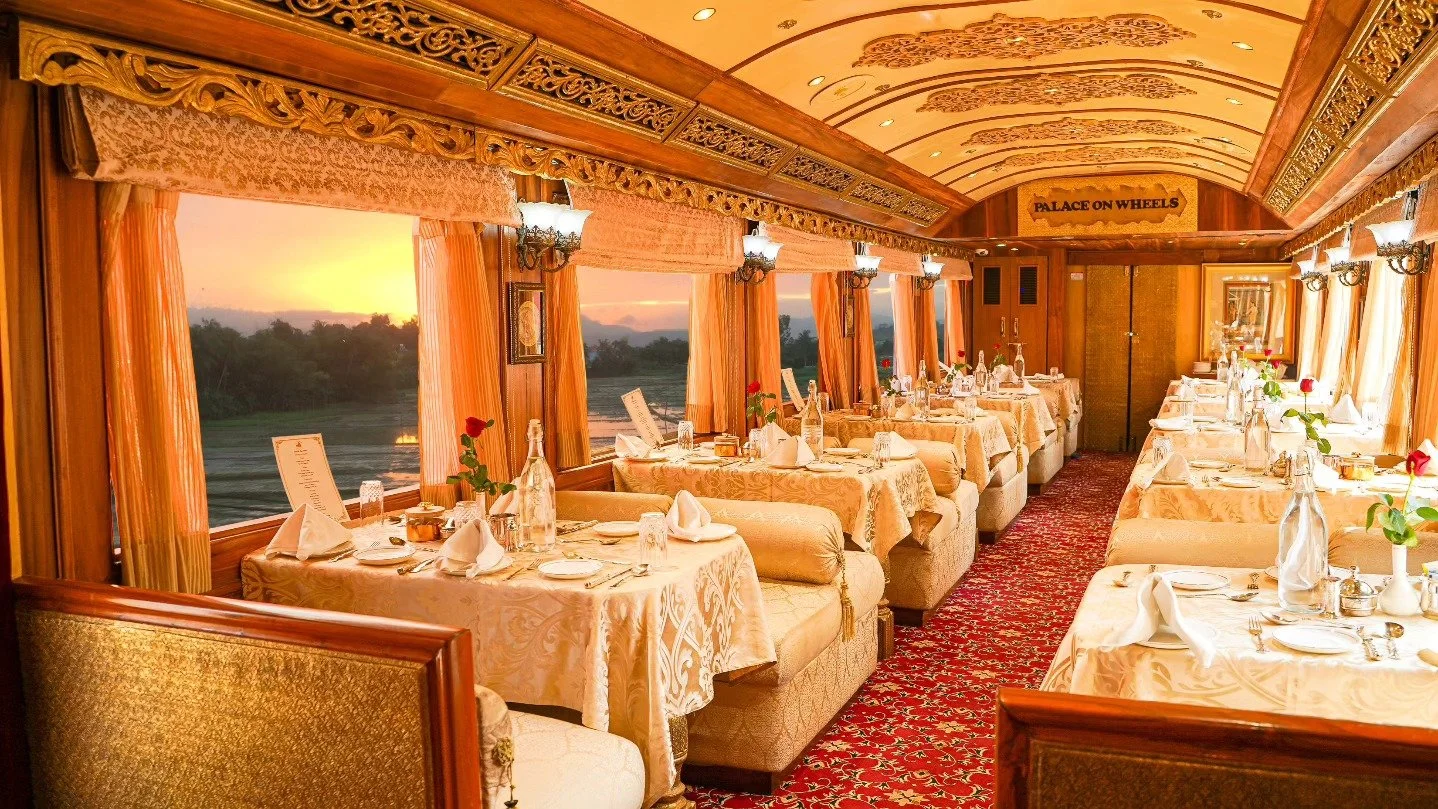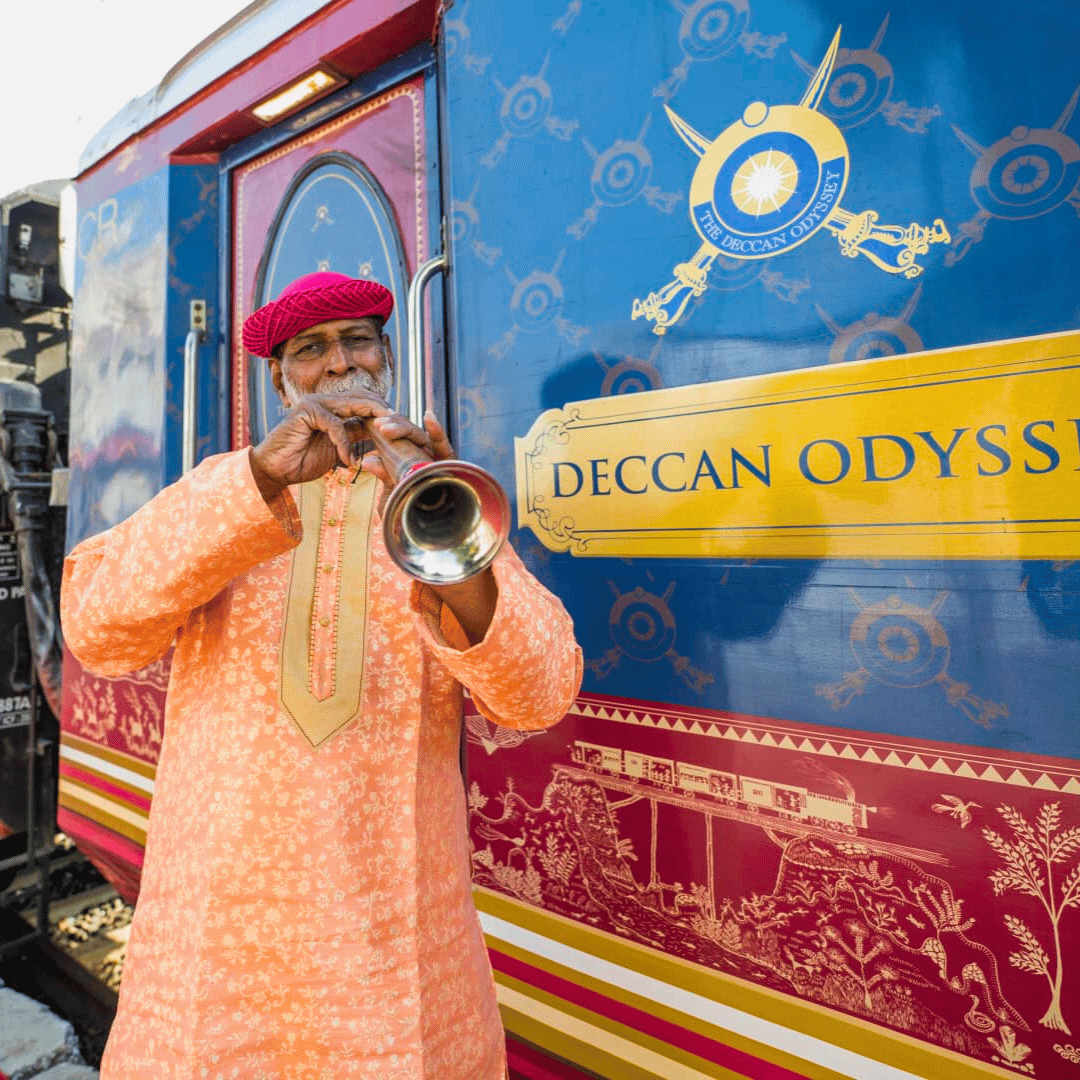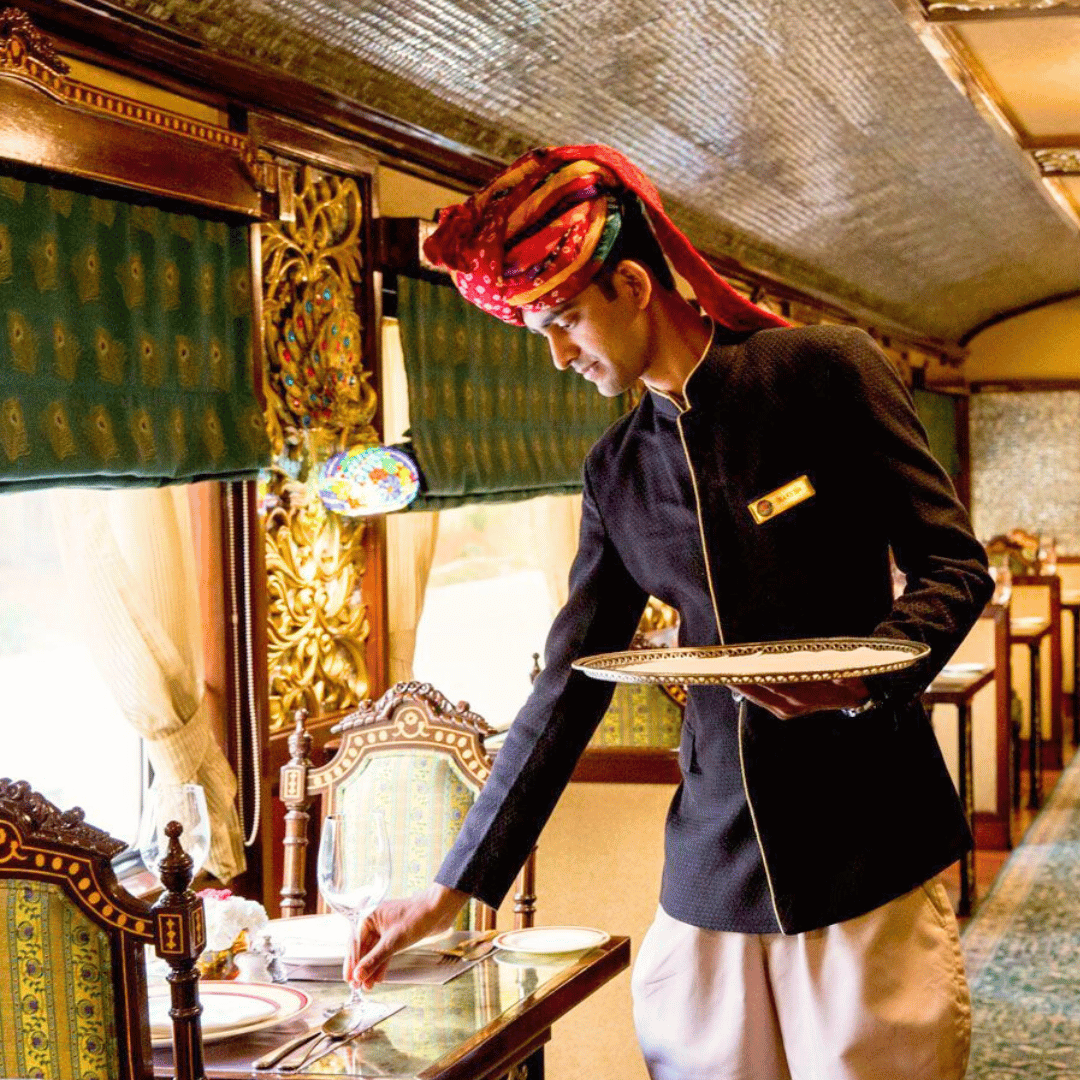
India Train Tours
Bespoke Packages Crafted With Care
Indian train tours offer an unhurried way to experience the country through its landscapes, culture and regional diversity. These journeys follow scenic routes, heritage rail lines and long-distance corridors that connect major cities with quieter corners of India, giving travellers a clear view of daily life from the comfort of a reserved seat or private cabin. Train trips in India can include the hill railways of Darjeeling, Shimla or Ooty, or luxury multi-day circuits such as the Maharajas Express, Palace on Wheels, Deccan Odyssey and Golden Chariot. Your rail journey can also becomes a part of a broader private tour of India, with your very own driver, curated sightseeing and regional insights that extend beyond the train itself.
Ideal for travellers interested in landscapes, history and a slower way to move across the country, Indian train tours blend comfort, discovery and thoughtful planning. Designed for each guest, our itineraries combine India’s most atmospheric rail routes with flexible touring and expert local guidance. Based in Melbourne and creating private India tour packages since 2007, India Unbound helps Australian travellers experience India by rail in a comfortable, authentic and well-supported way.
Luxury Train Tour Operators In India
Practical Travel Advice For Train Trips In India
-
Luxury train journeys in India follow clear regional circuits, each shaped by local history, landscapes and cultural strengths. Rajasthan remains the most prominent focus, with trains such as the Palace on Wheels and the Maharajas Express travelling through Jaipur, Jodhpur, Udaipur and the desert around Jaisalmer. These routes suit travellers drawn to forts, palaces, Mughal and Rajput heritage and lively markets. Distances are manageable, making this the most popular option for a first time luxury rail holiday.
Central India and Maharashtra are central to the Deccan Odyssey’s itineraries, linking Mumbai, Nashik, Aurangabad and the UNESCO listed Ajanta and Ellora Caves. These routes appeal to travellers interested in archaeological sites, early Buddhist and Hindu art and a quieter, more reflective style of travel. Some departures extend towards lesser visited towns and older trading centres, offering access to places that usually require long and complex road journeys.
Southern India is covered by the Golden Chariot, which connects Bangalore with heritage towns and landscapes across Karnataka. Key stops include Mysore, Hampi, Badami and, on some departures, the coastal region near Goa. Travellers who prefer temple architecture, early South Indian empire capitals and softer winter weather tend to choose these routes. The pace is generally relaxed and combines cultural highlights with rural scenery and smaller settlements.
Several itineraries also include wildlife experiences, especially in Rajasthan and Maharashtra. Game drives in parks such as Ranthambhore, Tadoba or Pench are incorporated into set departures, attracting guests who want a balance of culture, nature and comfort without long overland transfers. This combination suits travellers who like variety but want the convenience of a fixed, well supported schedule.
Across all operators, these routes cover a broad spread of India’s geography. Travellers use luxury trains to reach regions that would be difficult to combine independently in a short timeframe, relying on curated excursions, reliable logistics and an organised rhythm of travel that removes the usual complexity of exploring India by road. Plus, you only need to unpack once!
-
Luxury trains in India are designed to feel like small, well run boutique hotels on rails. Cabins are private, air conditioned and fitted with en suite bathrooms, comfortable bedding and daily housekeeping. Space varies by train and cabin category, but all provide enough room to unpack properly, relax between excursions and sleep well while the train moves overnight.
Service is attentive and consistent. Each carriage has dedicated staff who assist with luggage, tea and coffee, wake up calls and general requests throughout the journey. They manage the small details that make the trip smooth, from coordinating laundry to helping guests prepare for early departures or late returns from sightseeing.
Dining is a highlight, with restaurant cars serving a mix of Indian and international dishes. Meals are plated and served at your table, and menus change across the journey. Dietary needs can usually be met with notice, and staff keep track of preferences so guests do not have to repeat them. Some trains include soft drinks and house beverages, while others offer a separate bar service.
Excursions are well organised and always escorted by trained local guides. Transport, entrance fees and porterage are covered, so guests move through each day with minimal effort. Groups are usually small, timings are managed carefully and the pace is designed to avoid the rushed feeling of large group tours.
Overall, the comfort level sits between a quality heritage hotel and a small luxury resort, with the added benefit of slow travel, privacy and the ease of unpacking once. The service style is warm, unobtrusive and geared towards travellers who want structure without losing flexibility or personal attention.
-
Meals and guided excursions are included on all major luxury trains in India. Each train operates as a hotel on wheels, with dedicated dining cars serving breakfast, lunch and dinner each day. Menus feature Indian and international dishes, and dietary needs can be managed with notice. Some operators include soft drinks and house beverages, while others treat alcohol as an additional cost.
Guided excursions form the structure of each journey. Every itinerary includes off-train sightseeing with private transport, entrance fees and an English speaking local guide. Depending on the route, visits may include forts, palaces, cave temples, markets, stepwells or historic centres. Wildlife focused journeys also include scheduled game drives in national parks as part of the program.
The logistics are designed to be seamless. Train staff coordinate timings, transfers, monument tickets and porterage, so guests move through each day without having to organise anything themselves. Groups stay small, the pace is measured and the experience avoids the rushed style of large coach tours.
A few elements sit outside the standard inclusions, such as premium drinks, spa treatments, special camera tickets at monuments and private add-on tours. Taxes are another detail that can vary between operators, as not all trains include them in the base fare. It’s best to check with us before booking so we can confirm the exact inclusions for your preferred departure.
-
All of India’s main luxury rail fleet are set up as small, self contained hotels, so cabin types are broadly similar in concept but differ in size and layout.
In every case you get an air conditioned, en suite cabin with proper beds, storage, a small wardrobe or cupboard and space for luggage under the bed. The differences sit in how many categories there are on each train, and how many cabins are configured as twin or double, which matters if you are a couple, friends travelling together or a solo traveller booking single occupancy.
On the Maharajas Express, there are four cabin categories. Deluxe Cabins are the entry level option, with a mix of twin and double layouts, and are the main choice for most guests. Junior Suites are larger, again with both twin and double options and a small seating area for working or relaxing. Suites are more spacious again with a separate lounge style area and are always sold as double accommodation. At the top is the Presidential Suite, which effectively takes up its own carriage and includes two bedrooms, one with a double bed and one with twin beds, plus a living and dining space. Solo travellers book any of these cabins on a single occupancy basis rather than in a special single cabin.
Palace on Wheels is built around two main categories. Most guests stay in Deluxe Cabins, which are arranged across several carriage “states” and are mostly twin bedded with a small number of double bed cabins. Each cabin has an en suite bathroom, writing desk, wardrobe and a window seat. Above this is the Super Deluxe or Presidential level, with just two large suites that occupy their own carriage and offer more space and a larger bed, along with more personalised service. Again, single travellers use the same cabin types, with fares set for single deluxe occupancy rather than separate solo cabins.
Deccan Odyssey keeps things simple with Deluxe Cabins and Presidential Suites. Deluxe cabins come in twin, double and a very small number of dedicated single bed cabins, spread across the sleeping carriages. They all have en suite bathrooms, a small wardrobe and picture windows, and are designed for two guests but can be booked for solo use. Presidential Suites are larger, usually double bedded, with extra floor space for seating and a more generous bathroom. This train tends to appeal to guests who like a quieter, more contained environment but still want the suite option.
The Golden Chariot, which runs in South India, is made up entirely of Deluxe Cabins but offers a clear split between twin and double configurations. There are more twin cabins than doubles, plus one specially equipped accessible cabin for guests with reduced mobility. Inside, the cabins are much the same apart from the bed layout, with en suite bathrooms, a small desk, wardrobe and entertainment system. Solo travellers typically book a twin or double cabin for single use and pay a single supplement, as there is no separate solo category.
Across all four trains, cabin sizes are comfortable but not as large as hotel rooms, so luggage planning matters. As a rule of thumb, plan on one medium suitcase per person that can slide under the bed, plus a smaller soft bag or daypack that can sit in the wardrobe or on a luggage rack. Very large, hard shell cases are awkward to store and make the cabin feel cramped, especially in twin layouts. If you are unsure, ask us when you book and we can advise on sensible luggage limits for your specific train and cabin type.
-
Most travellers take luxury train journeys in India between October and March, when temperatures are more comfortable across the regions these routes cover. Rajasthan, Maharashtra and Karnataka all experience cooler mornings and warm, dry days during this period, which makes sightseeing easier and the long off-train excursions more enjoyable. This is also the clearest season for photography, with lower humidity and better light.
April and early May are still possible for train travel, but the heat rises quickly, especially in Rajasthan and Central India. Journeys in this period are quieter and can suit travellers who prefer fewer crowds, but the midday temperatures can be intense during city tours. Wildlife focused itineraries sometimes benefit from these hotter months, as animal sightings are often better when water sources shrink.
Most luxury trains do not operate during the summer monsoon from late May to September. Rainfall varies by region, but the combination of heat, humidity and heavy showers makes sightseeing less predictable, and maintenance schedules for the trains are usually planned for this window. South India receives earlier and heavier monsoon rains than the north, which also affects operating calendars.
If you are planning a once-in-a-lifetime rail holiday, aim for the core winter season from late October to early March. This gives you the most reliable weather, the broadest choice of departure dates and the most comfortable conditions for the extended days spent visiting caves, forts, palaces and historic towns. For specific travel dates, we can advise which trains are running and which regions offer the best seasonal experience.
-
Absolutely! The train journey itself follows a fixed route and schedule, but everything before and after it can be tailored. Most guests pair their rail holiday with private land based touring through India Unbound, which lets them explore regions and experiences not covered by the train itinerary. Private touring is flexible, with your own driver and local guides, so you set the pace and avoid the large group format.
This approach adds variety to the holiday and balances the structure of the train with more personalised time on the ground. You can choose market walks, architecture tours, countryside stays, guided museum visits, food experiences or simply quieter days to settle into the destination.
River cruising can also be added. Many travellers link a luxury rail journey with a Brahmaputra or Ganges cruise for a slower, more immersive look at rural India. These itineraries pair well with train travel because they offer a completely different style of movement and access to regions not reachable by rail.
If you have specific experiences in mind, we can plan the order, secure the right hotels and coordinate transfers so the entire trip - rail, private touring and cruising - runs as one smooth itinerary.

Popular Luxury Train Trips In India
Plan Your Indian Rail Holiday With India Unbound
Established in 2007, India Unbound is an award-winning travel company specialising in custom-made journeys and private tours to India. With more than two decades of experience exploring this fascinating nation, we create tailor-made itineraries for discerning travellers looking for a real adventure.
When you start to research a trip to India, it’s easy to feel overwhelmed by the seemingly endless possibilities. At India Unbound, we’ve made this process easy. To see India, we simply need you to tell us relevant information about yourself and the type of travel experience you are looking for - whether it’s a wish list of places you want to visit, a style of travel, a particular interest or theme that you want to explore, or all of these factors. Using this information, we curate a custom-made India private tour just for you. It’s that simple.









